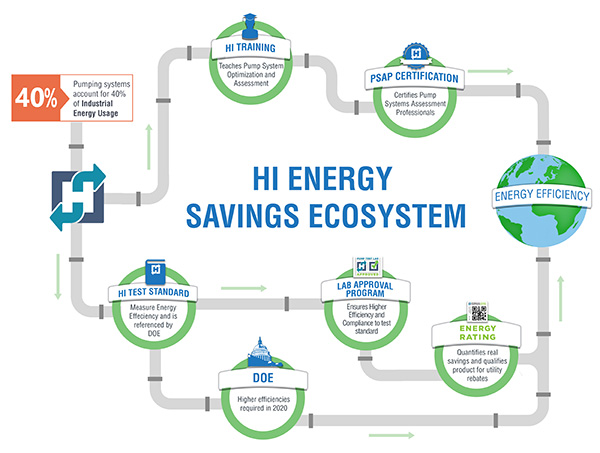The pump industry is a key player in meeting energy conservation goals under the new U.S. administration.
The recent shift in the U.S. administration signifies a reconsideration of environmental policy, which previously eased regulation around energy efficiency and water conservation. A renewed focus on energy efficiency aligns nicely with industrial leaders seeking to do their part and contribute to achieving our sustainability goals.
The most recent bipartisan infrastructure bill pending in Congress would provide the largest investment in climate resilience funding in American history. This serves as a proof point that the administration plans to act on their policy of energy efficiency. Industries that hold this goal at the core of their operations will emerge as leaders. There is a clear path for them to play a leading role.
While the specifics of how policy will be implemented is deliberated, there are options of efficiency for the here and now. As government leaders in the US and around the world drive new sustainability goals, industry leaders can do their part as well.

Pump systems account for 40 percent of industrial fluid system energy usage, so simply replacing old equipment with more efficient equipment, or re-examining the system’s current needs and optimizing the pumping system is an enormous opportunity for energy savings. Pump systems often go unchanged within a processing system or a building, essentially from the time it is designed and constructed to when it is taken out of service. If the right decisions are made during the design phase, the pumping system will be optimized, and the energy savings will accrue for the life of the system. However, as system requirements change, so should the pumping system.
While the proposed legislation will likely support the creation of new industries based on new, and un-proven “green” technologies, it also supports investing in the nation’s water and wastewater infrastructure. In my mind, these are not separate issues.
Many new green technologies need time to prove their efficiency – along with their commercial viability and commercial payback. This is where pumps are different. The technology is proven – and proven to be efficient.
Simply replacing old, inefficient pumps may not sound like the game changer technology, but it just might be. There is no payback period which needs to be measured. Pumps are a readily available and well-tested technology which have stood the test of time. There is no time wasted in testing to see if it is worth the investment, the proof is in a long-standing history of energy-efficient pumps and an industry that is fully behind making it happen.
The industry has already begun to see some administrative changes create a domino effect. Back in 2016, the Department of Energy negotiated a term sheet that would be the basis of regulation for commercial and industrial pumps. With the change of administration, they are moving forward with regulations that were previously on hold for circulator pumps. The Hydraulic Institute is working with the Department of Energy and responding to requests for information surrounding pumps and their labeling. The current request to HI by the DOE is an indicator of the implementation of new environmentally conscious policies to come.
The Hydraulic Institute (HI) is working to improve energy efficiency across a wide range of industries. One example of this is the emphasis on labeling the institute has recently developed. The HI Energy Rating Label program is designed to clearly indicate the power savings obtained from pump system upgrades and changes. By creating a baseline measurement of efficiency, key players in the industry are held accountable for their environmental impact. With the rating information, run time and electricity rate the system owner can easily calculate the cost to power the pump. Selecting pumps with a higher Energy Rating is the simplest way to advance towards sustainability goals.
As the industry and country strive for more energy-efficient solutions and to make a substantial impact toward sustainability, the optimization of the pumping systems – both in the industrial processes and the buildings around them is a powerful tool to get us closer to those goals. Industry support for sustainability goals can happen with the equipment and the tools we have today. Considering the impact commercial and industrial pumps, and circulator pumps can yield in minimizing energy use and saving water, the proper use and selection of pumps can make an enormous impact. Pumps are a simple technology, however, are often an overlooked solution to reaping energy savings for years to come.
The Hydraulic Institute’s full ecosystem of energy efficiency solutions includes training, certification programs, and standards. For more information on these programs, please visit pumps.org/EnergyEfficiency.

About the Author
Michael B. Michaud is the Executive Director of the Hydraulic Institute, the largest association of pump industry manufacturers in North America. Since joining HI in 2015, Michaud has expanded the Institute’s portfolio of efficiency programs by launching the HI Energy Rating Label and the Pump System Assessment Professional (PSAP) Certification.
Prior to joining the Hydraulic Institute, Michaud spent 19 years in leadership positions at the American Society of Mechanical Engineers (ASME), where he was responsible for developing and implementing global strategy, managing the International Gas Turbine and Petroleum Institutes, and growing professional development and training activities around the world.


In this episode, I sat down with Beejan Giga, Director | Partner and Caleb Emerson, Senior Results Manager at Carpedia International. We discussed the insights behind their recent Industry Today article, “Thinking Three Moves Ahead” and together we explored how manufacturers can plan more strategically, align with their suppliers, and build the operational discipline needed to support intentional, sustainable growth. It was a conversation packed with practical perspectives on navigating a fast-changing industry landscape.